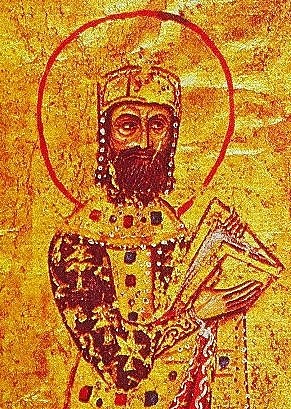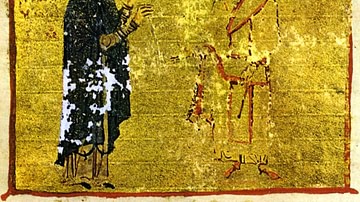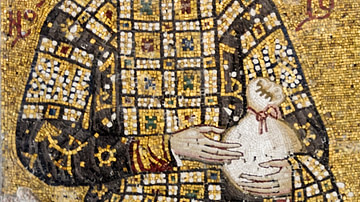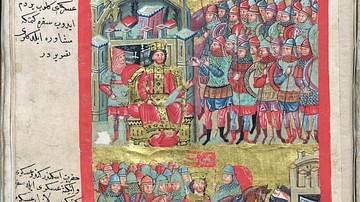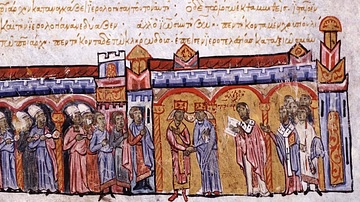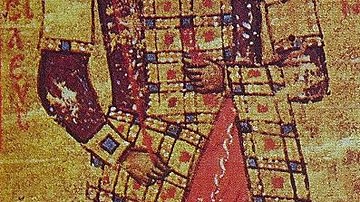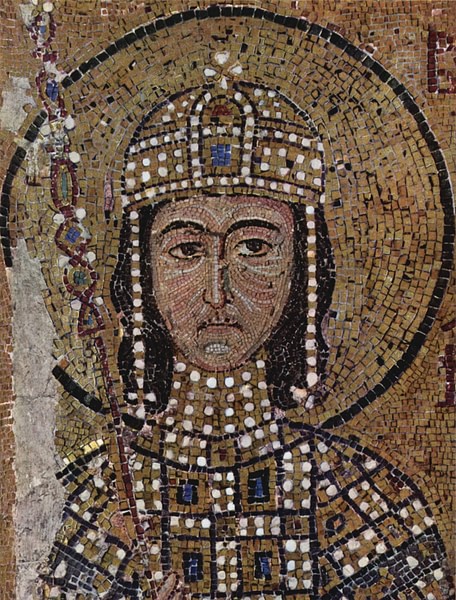
Anna Komnene (aka Anna Comnena, 1083-1153 CE) was the eldest daughter of Byzantine emperor Alexios I Komnenos (r. 1081-1118 CE) and the author of a lengthy biography of her father's reign, the Alexiad. Although not an impartial history, Anna's position at court, her thorough research of sources and a good measure of pithy observation and insightful opinion have all ensured the Alexiad remains one of the most important and colourful primary sources of Byzantine history.
Early Life
Anna Komnene was born in 1083 CE in the Porphyra, the purple room of the Byzantine royal palace in Constantinople where royal babies were usually born and which was a potent symbol of royal legitimacy. She was the eldest daughter of Alexios I Komnenos and his wife the Empress Irene Doukaina. The emperor had no sons and so, for a time, Anna was the official heir following her betrothal to Constantine Doukas, the son of Michael VII (r. 1071-1078 CE). Constantine was nine years older than Anna and the empress-to-be later wrote of him in the following glowing terms:
[Constantine was] seemingly endowed with a heavenly beauty not of this world, his manifold charms captivated the beholder, in short, anyone who saw him would say, He is like the painter's Cupid (Herrin, 233)
Anna went to live with her future mother-in-law Maria of Alania where she was educated in mathematics, philosophy and medicine. A higher education was not regarded as becoming for a lady at court but Anna pressed ahead anyway and secretly hired Michael of Ephesos to tutor her in the more complex branches of philosophy, examining the works of Aristotle, in particular.
The path of Anna's future changed dramatically in 1087 CE when Alexios had a son, John, who became his chosen heir and the object of Anna's jealous hatred for the rest of her life. When Constantine Doukas died an early death in 1097 CE, Anna, still only 14, wasted no time and married the gifted general Nikephoros Bryennios the Younger. The couple would go on to have four children. She then plotted with her grandmother, Anna Dalassene, to make her new husband the next emperor. This plan failed, largely because Nikephoros remained loyal to the official heir John and stayed away when the rebels prepared to seize control of the palace.
When Alexios died of disease on 15 August 1118 CE, his son John became emperor John II Komnenos (r. 1118-1143 CE). It seems probable that Anna was involved in an assassination attempt aimed at John during their father's funeral, of all places, and within a year John had banished his scheming sister to the monastery of the Virgin Kecharitomene. All of Anna's property was confiscated and she was prohibited from ever entering the royal palace at Constantinople again.
Banishment & the Alexiad
At least Anna's forced seclusion allowed her to write her Alexiad (aka Alexias) history in peace and, with what turned out to be a sentence of 35 years, time was not a problem. The Alexiad was begun c. 1137 (perhaps not coincidentally the year her husband died) and was worked on steadily through the mid-1140s CE. It covers the period of Byzantine history from 1069 to 1118 CE. Principally a tribute to her father and his 37-year reign, the work is the only such book written by a woman in the Middle Ages.
Consisting of 13 books written in Attic Greek, the Alexiad can be broadly divided into the following subject areas:
- Books I-III cover the rise of the Komnenos family and justify the clan's seizure of power.
- Books IV-IX cover various wars such as those against the Normans, Scyths, Turks and Cumans.
- Books X-XI cover the First Crusade (1096-1104 CE) and the 1105 CE Norman invasion of Byzantium.
- Books XII-XIII cover more military escapades and such domestic issues as the most infamous church heretics (e.g. the Manicheans and Bogomils).
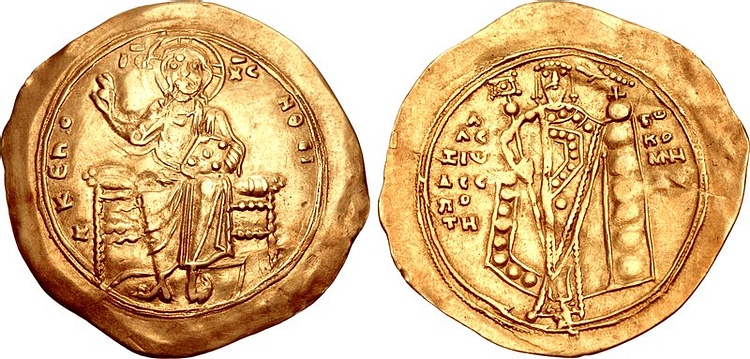
Anna used and referenced earlier works such as the Chronographia of Michael Psellos (1018 - c. 1082 CE) as well as official reports, treaties, archival records, eye-witness accounts from battles, hearsay, and the speeches and audiences she herself witnessed at court. Thus Anna's description of 11th century CE Byzantium, which covers not only major events but also many physical descriptions and other details such as protocols and clothing, has become an invaluable source for modern historians. Anna was also keen that her work present an objective view of events, although she herself admits the Alexiad is somewhat prejudiced, or at least an incomplete biography of her father, for the following reasons:
And truly when writing this, partly from the nature of history and partly because of the extravagance of the events, I forgot that it was my father's deeds that I was describing. In my desire to make my history free from suspicion, I often treat my father's doings in a cursory way, neither amplifying them nor investing them with sentiment. Would that I had been free and released from this love of my father, in order that I might have, as it were, laid hold upon the rich material and shown the license of my tongue, how much at home it is in noble deeds. But now my zeal is hampered by my natural love, for I should not like to afford the public a suspicion that in my eagerness to speak about my relations I am serving them with fairy tales! Indeed very often I recall my father's successes, but I could have wept my life away in tears when recording and describing the many ills that befell him, and it is not without private lamentation and plaint that I quit the subject. But no elegant rhetoric must mar this part of my history, and therefore I pass lightly over my father's misadventures, as if I were an insensible piece of adamant or stone…let my father's woes be a subject of marvel and lamentation to me alone. (Gregory, 291-2)
Certainly, Anna presents a glowing character portrait of her father whom she saw as 'a fiery whirlwind…radiating beauty, grace and dignity and an unapproachable majesty' (quoted in Norwich, 248). As an example of the rather exaggerated presentation of Alexios' great deeds - by no means an uncommon approach of historians of the period - Anna presents the following account of the emperor, in 1082 CE, defending himself with aplomb against three fierce Latin knights who:
…took long spears in their hands and at full gallop dashed at the Emperor. Amicetas missed the Emperor because his horse swerved a little; the second man's spear the Emperor thrust aside with his sword and then bracing his arm, struck him on the collarbone and severed his arm from his body. Then the third aimed straight at his face, but Alexios being of firm and steadfast mind was not wholly dismayed, but with his quick wit grasped in the flash of an instant the thing to do, and when he saw the blow coming, threw himself backwards on to his horse's tail. Thus the point of the spear only grazed the skin of his face a little and then, hitting against the rim of the helmet, tore the strap under the chin which held it on and knocked it to the ground. After this the Frank rode past the man he thought he had hurled from his horse, but the latter quickly pulled himself up again in his saddle and sat there calmly without having lost a single weapon. And he still clutched his naked sword in his right hand, his face was stained with his own blood, his head was bare, and his ruddy, gleaming hair was streaming over his eyes and worrying him, for his horse in its fright spurned the reins and by its jumping about tossed his curls in disorder over his face; however, he pulled himself together as much as possible and carried on his resistance to his foes. (ibid, 292)
Other prejudices revealed in the Alexiad include the typical Byzantine feeling of superiority over other cultures, as in this passage which describes the Franks:
[The emperor] heard a report of the approach of innumerable Frankish armies. Now he dreaded their arrival for he knew their irresistible manner of attack, their unstable and mobile character and all the peculiar natural and concomitant characteristics which the Frank retains throughout; and he also knew that they were always agape for money, and seemed to disregard their truces readily for any reason that cropped up. (ibid, 295)
Still, in amongst the cliches of the dishonourable foreigner, there are more literary and more revealing passages of the times, for example:
And those Frankish soldiers were accompanied by an unarmed host more numerous than the sand or the stars, carrying palms and crosses on their shoulders; women and children, too, came away from their countries. And the sight of them was like many rivers streaming from all sides. (ibid, 296)
Death & Legacy
Besides her own work, Anna formed and hosted a notable literary circle and, in the tradition of philanthropic empresses and court ladies, she sponsored other scholars such as Eustratius of Nicaea. Anna's Alexiad enjoyed immediate favour and she was recognised in her own lifetime as a scholar of note. Her achievements and contribution to Byzantine history are perhaps best summarised by the oration given at her funeral by George Tornikes:
A woman wiser than men in words, more manly in acts, more firm in plans, more prudent in tests…a woman enriched by three eyes of perception, those of her natural perspicacity, of scientific penetration and of consummate experience (Herrin, 232).
